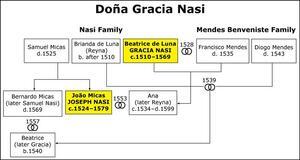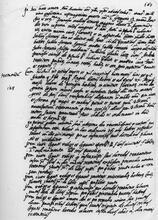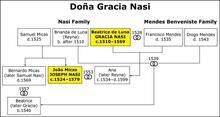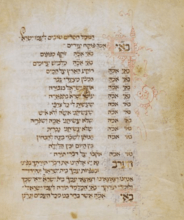Doña Gracia Nasi
As a young woman Doña Gracia Nasi inherited her husband’s fortune. After the Portuguese Inquisition was established in 1536, she was forced to flee Lisbon. After navigating dangerous political waters, the family eventually settled in Venice, where they continued to practice crypto-Judaism while maintaining a Catholic façade. After the Venetian court involved itself in a familial inheritance dispute, Gracia Nasi moved her family and property to Ferrara, where they lived openly as Jews for the first time. She was an active supporter of literary activities among Ferrara Jews – she was also instrumental in financing and organizing transportation and resettlement for conversos fleeing Portugal. In 1552, the family moved to Constantinople. Gracia Nasi assumed a role of leadership in the Sephardi world of the Ottoman Empire, providing relief to needy Jews, supporting rabbinic scholars, and establishing synagogues.
Doña Gracia Nasi (c. 1510–1569) was among the most formidable figures of the Sephardi world in the sixteenth century. Her dramatic (indeed melodramatic) life began in Portugal, where she was born into a Jewish family whose members had recently been forcibly baptized. It ended in Constantinople (now Istanbul) after a career that brought her renown as a shrewd and resourceful businesswoman, a leader of the Sephardi Lit. (Greek) "dispersion." The Jewish community, and its areas of residence, outside Erez Israel.Diaspora, and a generous benefactor of Jewish enterprises. She became known among her contemporaries simply as “La Señora.”
Family, Marriage, & Widowhood
Little is known of her early life. She was descended from a distinguished Spanish Jewish family bearing the name “Nasi.” Her parents may well have been among the Spanish-Jewish exiles who left Spain for Portugal in 1492, only to be forcibly baptized in Portugal in 1497. In any case, the family assumed “de Luna” as its Christian name. The child who was to become Gracia Nasi was born around 1510 and was named Beatrice.
In 1528 Beatrice married Francisco Mendes Benveniste, a wealthy New Christian merchant in Lisbon, whose fortune derived from trade in the East Indies. With her husband’s death in January 1535, Beatrice was left a young widow with an infant daughter Ana (c. 1534–1599). It is noteworthy that in his will Francisco divided responsibility for the administration of his fortune between his wife and his brother (and business partner) Diogo (d. 1543), a fifty-year-old merchant in Antwerp who, since 1525, had been a leading figure in the Portuguese pepper and spice trade. Francisco evidently recognized his young wife’s intelligence and resourcefulness.
These were qualities that, as fate would have it, Beatrice would sorely need. At the time of Francisco’s death the very survival of the family was threatened by developments on the religio-political scene: On May 23, 1536, the pope ordered the establishment of a Portuguese Inquisition on the Spanish model. For the previous four decades, the Nasi and Mendes families had almost certainly maintained crypto-Jewish traditions while outwardly conforming to Catholicism. An arrest of its members by the Inquisition would probably have meant conviction and the confiscation of the family fortune.
Resettlement in Antwerp
It was under these circumstances that, shortly after her husband’s death, Beatrice Mendes left Lisbon with her daughter Ana and her younger sister Brianda (b. after 1510). After a brief stay in London, the Lisbon emigres joined Diogo Mendes in Antwerp, which at the time was the leading financial center of Europe. It was also, however, under Spanish rule, and thus within the jurisdiction of the Spanish Inquisition. Indeed, Diogo had had a brush with the Inquisition: he was arrested in 1532 and released only after intervention by the king of Portugal, João III (r. 1521–1557). The resettlement in Antwerp of the Lisbon members of the family probably had a temporary aim, namely to organize for removal to a more secure place and to transfer the family fortune.
Ties between the Mendes and de Luna family were reinforced in 1539, when Brianda de Luna married Diogo Mendes. A daughter born to them the following year was named Beatrice after her aunt. But Diogo died in the summer of 1543, greatly complicating matters. In accordance with his brother’s will, half the family property remained in Beatrice Mendes’ hands. But he, too, must have recognized Beatrice’s merits, for he made her the administrator of his own half of the fortune, on behalf of his widow Brianda and their daughter. This decision was no doubt intended to provide the wisest administration of the estate, but it led to a personal rift between the two sisters (Beatrice Mendes and Brianda Reyna Mendes) that would produce great difficulties in the years to come.
Beatrice Mendes’s ability to navigate dangerous political waters was soon tested. Charges of crypto-Judaizing were brought against her deceased husband (Francisco Mendes), undoubtedly with the aim of relieving the family of the bulk of its enormous fortune. She succeeded in having the charges withdrawn by negotiating the payment of a large bribe, along with the loan of an enormous sum, to the emperor Charles V (1500–1558). But other threats appeared as well, in the form of aggressive suitors seeking, with imperial support, her daughter Ana’s hand—the prize, of course, being her inheritance. Beatrice adroitly withstood pressures from court on this matter, until in 1544 she was able to organize the family’s flight to Venice.
Flight to Venice & Familial Conflict
The imperial government, angered by the family’s flight, retaliated by accusing the Mendes sisters of apostasy and placing an embargo on both the property they left behind in Antwerp and the debts owed to them. Beatrice’s nephew João Micas (Joseph Nasi, c. 1524–1579), on whom Beatrice Mendes increasingly relied, entered into lengthy negotiations to arrive at a settlement. With skillful maneuvering João was able to retrieve much of the embargoed property, though much was also lost. Then he, too, departed suddenly for Venice, arriving there in early 1546.
In Venice, the family took up residence on the Grand Canal. Beatrice and her family were almost certainly practicing Judaism clandestinely, but they continued to maintain a Catholic façade for strategic reasons as well as out of self-interest, the Jews of Venice being confined to a crowded and insalubrious ghetto. They must have been reassured by the fact that the Venetian authorities tended to turn a blind eye to the religious apostasy of converso emigrés from Spain and Portugal, except in rare cases when they were stirred to action. But this was a rare case, given the family’s great wealth. An opportunity for action presented itself when a dispute broke out between Brianda and Beatrice over Beatrice’s control of the family fortune. The quarrel was brought before the Venetian Giudici al forestier (tribunal for the affairs of foreigners). Probably aware of the possibility of the family’s flight to Constantinople, the tribunal ruled in two decisions, of September 1547 and December 1548 respectively, that Beatrice was to hand over half the Mendes fortune to the public treasurer of Venice, to remain there until her niece Beatrice (b. 1540) was eighteen.
By the time of the decision, however, Beatrice Mendes had already organized to move her family and property to Ferrara. The ruler of Ferrara, Ercole II, Duke of Este (1508–1559), was eager to have the Mendes family and their commercial assets in his territory. He therefore agreed to accept the terms of Diogo Mendes’s will, leaving Beatrice in control of the entire fortune. He received Beatrice and her daughter with honor in 1549; Brianda had no choice but to follow. In Ferrara, the family lived openly as Jews for the first time, and it was probably here that Beatrice became known as Doña Gracia Nasi. Brianda probably adopted the name Reyna. Somewhat confusingly, Gracia’s daughter Ana was also given the name Reyna, and Brianda’s daughter was given the name Gracia. However, this did not prevent the sisters’ struggle over the family fortune from continuing.
Charitable Activities in Ferrara
At the time of Gracia Nasi’s settlement in Ferrara, that city had a distinguished Sephardi colony, which included many ex-conversos from Portugal. In addition to managing the family firm, Gracia was soon an active supporter of the remarkable burst of literary and printing activity among Ferrara Jews. The most influential work to be produced was the famous Ferrara Bible (1553), a vernacular Spanish translation of the Hebrew Bible produced by Abraham Usque and Yom Tov ben Levi Athias. Two versions of this work were printed for different markets. It was an indication of the stature and influence which Gracia Nasi had already attained that the version intended for Jewish use was dedicated to her. The same year saw the publication in Ferrara of Samuel Usque’s epic work in Portuguese, Consolation for the Tribulations of Israel, intended for a Portuguese-speaking ex-converso public. It, too, was dedicated to Doña Gracia, whom Usque called “the heart within the body” of “our Portuguese [i.e., ex-converso] nation.” A lengthy passage of the book describes Gracia Nasi’s dedicated efforts to aid conversos fleeing Portugal and resettling in Italy or the Ottoman Empire. According to Usque, Gracia Nasi was instrumental in financing and organizing transportation and basic necessities for those in need. Presumably she made use of her network of commercial agents in Portugal and northern Europe to gather information and transmit funds.
By the time these works actually appeared in print, however, Gracia Nasi had already left Ferrara and returned to Venice. There, a visiting Turkish emissary mediated between the sisters and negotiated an agreement in June, 1552, which was ratified by the Venetian Senate. According to the agreement, Gracia Nasi handed over one hundred thousand gold ducats to the Venetian public treasurer, for safekeeping until Brianda’s twelve-year-old daughter Gracia reached the age of fifteen. Brianda received a relatively modest sum as a dowry and compensation.
Leadership in Constantinople
With the atmosphere in Counter-Reformation Italy becoming increasingly hostile, the resolution of the sisters’ conflict came none too soon. Gracia Nasi and her daughter took the long-anticipated step of departing from Italy in August, 1552, accompanied by a large entourage. They arrived the following spring in Constantinople. Gracia Nasi, who had long since succeeded in transferring a substantial part of the family fortune to the Ottoman capital, took up residence not amid the large Jewish population of that city, but in the fashionable European quarter of Galata, where she lived in grand style. Still deeply committed to Jewish life, she quickly assumed a role of leadership in the Sephardi world of the Ottoman Empire, dispensing charity, continuing her aid to fugitives from the Iberian Peninsula, providing relief to Jewish captives and Jews in distress elsewhere, and supporting rabbinic scholars, hospitals, and synagogues throughout the Ottoman Empire. She established a yeshiva and synagogue in the Ottoman capital, the “academy of the Geveret” (she was also known by this epithet) and the “synagogue of the Señora,” respectively. In 1559, as the influx of ex-conversos continued, she supported the foundation of yet another synagogue.
Meanwhile Brianda, who had chosen not to leave for Constantinople, remained in Venice with her daughter. Gracia Nasi and her nephew were not, however, content with this arrangement. Amid much intrigue in noble circles in Venice to have Brianda’s daughter married to one of them, João Micas, aided by his brother Bernardo, took the daring step of abducting the girl in January 1553 and hastily marrying her in Ravenna. Thereupon, the Venetian authorities intervened and succeeded in having the girl returned to her mother in Venice. João Micas embarked on diplomatic efforts to have his “wife” and her fortune restored to him, but without success. Meanwhile, after lengthy proceedings, the Venetian authorities banished João Micas from Venice. Gracia Nasi sent a ship from Ragusa to Ancona to fetch him and his brother Bernardo, and they embarked for Constantinople in November 1553. After his arrival in Constantinople, João Micas – now Joseph Nasi—may have made further efforts to have his “marriage” to Gracia Nasi’s niece recognized in Europe. But several months later, when these efforts appeared doomed, he took quite a different course: he was circumcised, assumed the Hebrew name Joseph Nasi, and married Gracia Nasi’s daughter, Reyna (Ana).
In Constantinople, Gracia Nasi continued to manage the family’s commercial and shipping activities, with agents acting on her behalf in major commerical centers in Europe. Joseph Nasi, who became a trusted partner in this enterprise, quickly secured a powerful place at the court of the sultan Suleiman I (b. 1494, reigned 1520–1566). His wife Reyna Nasi in time became a forceful figure in her own right, known for her support of charitable works. But Gracia Nasi maintained a unique reputation as the very embodiment of passionate solidarity among the exiles.
Boycott of Ancona
The most ambitious of Gracia Nasi’s interventions on behalf of Jews was the boycott of the port of Ancona in 1556—one of the rare acts of organized Jewish resistance to persecution in the pre-modern period. For two decades, ex-conversos from the Iberian Peninsula had lived as openly practicing Jews in Ancona, an Italian town under papal rule, with explicit papal consent and protection from inquisitorial prosecution. (They were technically liable to such prosecution because, having been baptized, their practice of Judaism made them apostates and heretics in the eyes of the Church.) The popes who granted them protection did so in order to encourage trade between Ancona and the Ottoman Empire, a task for which the Portuguese Jews were particularly well-suited. Not surprisingly, four agents of Gracia Nasi were counted among the Jewish merchants active in the city.
However, in May, 1555, there was a fateful change at the Vatican: the first of the militant “Counter-Reformation popes,” Paul IV (1476–1559; Pope 1555), ascended to the papacy. Only two months later, the new pope took sudden action against the ex-conversos in Ancona. Overriding the guarantees granted them by his predecessors, he initiated inquisitorial proceedings against them. The entire community of Portuguese Jews in Ancona was placed under arrest. When news of the arrests reached Constantinople, Gracia Nasi was among the influential Jews who persuaded the sultan to intervene diplomatically. The sultan sent an envoy with a letter demanding the release of the arrested Jews, whom he claimed to be under Turkish protection. The pope, however, agreed to turn over only their confiscated property. Some of the prisoners were able to escape, apparently through bribery of an official, but more than fifty were tried and convicted. In the spring and summer of 1556, twenty-four were burned at the stake, including Jacob Mosso, Gracia Nasi’s agent in Ancona.
As a protest and punitive measure, some of the arrested merchants, who had escaped to Pesaro, initiated the idea of a Jewish commercial boycott of Ancona and a diversion of the Ancona commerce to Pesaro. But to carry out such an enterprise required organization, and it was the Nasi family that had the means and the activist spirit to spearhead it. Gracia Nasi and her nephew Joseph exerted pressure for compliance with the boycott by Ottoman Jewish merchants and sought rabbinic support. However, there were delicate issues involved, and the risks were difficult to assess. The question of whether the boycott should be supported soon bitterly divided the Ottoman Jewish rabbis and communities, and, under these circumstances, the boycott fizzled out.
Fate of Gracia Nasi’s Niece
Shortly before papal action was taken in Ancona, Gracia Nasi’s niece, still living with her mother on the Grand Canal in Venice, came of age (June 1555). Only months later the two were banished from Venice after an inquisitorial investigation revealed that Brianda was harboring in her home a crypto-Jewish agent of the Mendes commercial firm. In early 1556 Brianda and her daughter Gracia moved with their possessions to Ferrara; but shortly thereafter, Brianda died unexpectedly, leaving young Gracia, after so many other tribulations, orphaned.
It was at this point that Joseph Nasi’s brother and erstwhile co-conspirator Bernardo (by then Samuel Nasi) arrived in Ferrara. At the end of the year’s mourning for Brianda—in June 1557, at the height of the split in the Jewish community over the Ancona boycott—he and the young Gracia were wed in Ferrara in a Jewish ceremony. (Gracia’s previous “marriage” to Joseph Nasi was clearly not regarded as valid by anyone.) The famous medal of “Gracia Nasi” (engraved in Hebrew letters), struck by the Ferrarese artist Pastorino de’ Pastorini (c. 1508–1592), depicts not Doña Gracia, as has often been assumed, but her niece at the age of eighteen; the occasion for producing the medal was apparently her marriage. New negotiations and pressure from the sultan were required before the duke of Ferrara allowed Samuel and Gracia to depart for Constantinople with the bride’s fortune intact, in 1558.
In the 1560s, Gracia Nasi together with her nephew became deeply engaged in a bold and strikingly forward-looking project—an effort to establish a self-sufficient Jewish settlement on the site of the ancient city of Tiberias in the Holy Land, as a refuge for conversos fleeing from Spain and Portugal. In a step that foreshadows later efforts, Joseph Nasi obtained a privilege from the sultan granting him the ruins of Tiberias with seven surrounding villages. Doña Gracia was said to have contributed large sums toward this project, and by 1566, despite local Arab opposition, a thriving settlement existed. It was short-lived, however. A generation later only a handful of families remained.
We have little knowledge of Gracia Nasi’s last years. When she died in 1569, the loss was deeply and widely felt. Her death spelled the loss of a legendary personality—a grande dame who, along with her sense of privilege and imperious behavior, symbolized triumph over great adversity, and intense devotion to Jewish life.
Adelman, Howard Tzvi. “The Venetian Identities of Beatrice and Brianda de Luna.” Nashim: A Journal of Jewish Women’s Studies & Gender Issues no. 25 (Fall 2013): 10-29.
Garshowitz, Libby. “Gracia Mendes: Power, Influence and Intrigue.” In Power of the Weak: Studies on Medieval Women, edited by Jennifer Carpenter and Sally Beth MacLean, 94–125. Urbana, IL: University of Illinois Press, 1995.
Grunbaum-Ballin, P. Joseph Naci: Duc de Naxos. Paris: Mouton, 1968
Ravid, Benjamin. “Money, Love and Power Politics in Sixteenth Century Venice: The Perpetual Banishment and Subsequent Pardon of Joseph Nasi.” In Italia Judaica, Atti del I Convegno internazionale, Bari, 18–22 maggio 1981. Rome: Multigrafica, 1983, 159–181.
Roth, Cecil. Doña Gracia of the House of Nasi. Philadelphia: Jewish Publication Society, 1948.
Salomon, Herman Prins and Aron di Leone Leoni. “Mendes, Benveniste, De Luna, Micas, Nasci: The State of the Art (1532–1558).” Jewish Quarterly Review 88 (1998): 135–211.
Saperstein, Marc. “Martyrs, Merchants and Rabbis: Jewish Communal Conflict as Reflected in the Responsa on the Boycott of Ancona.” Jewish Social Studies 43 (1981): 215–228
Segre, Renata. “Sephardic Refugees in Ferrara: Two Notable Families.” In Crisis and Creativity in the Sephardic World, 1391-1648, edited by Benjamin Gampel, 164–185. New York: Columbia University Press, 1997.






